How to work with polypropylene pipes: all about the features of installation work
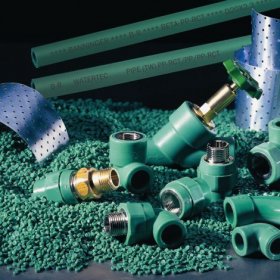
Independent laying of heating and water mains is not for everyone. But even those whose hands “grow where they should” cannot do without theoretical knowledge. This is especially true for complex processes. One of these is the installation of polypropylene pipes with your own hands. The main difficulty lies in the welding of polypropylene products. The reliability and durability of the trunk depend on the quality of the work performed. The pipes themselves have a high degree of strength. Therefore, problems with the line occur only in connection with a violation of the welding technology. What does this technology represent today and we will cover.
Content
Varieties of polypropylene pipes and fittings
Polypropylene pipes are unreinforced and reinforced. The first because of the large thermal elongation are used only for cold water supply. Reinforced - can be used in hot water supply systems, "warm floor”And heating lines.
For the installation of the pipeline, you may need:
- pipes, their diameter varies from 20 mm to 160 mm;
- bends of 45 ° or 90 ° are necessary for turning the pipeline in the right direction;
- couplings connect pipes to each other;
- tees, serve for branching the pipeline in three directions;
- crosses, branch the pipeline in four directions;
- adapters for connecting pipes of different diameters;
- detachable connectors, taps;
- bushings, plugs;
- clips for mounting the pipeline.
You can learn more about the types of pipes from the video:
Detailed description of the welding process
To master the process of installing polypropylene pipes, it is necessary to study the welding technology. Tools necessary for work: marker; measuring tool; precision scissors, auto-scissors or pipe cutter; for reinforced shaver products; welding tool.
How to prepare a polypropylene pipe?
Using a tape measure, measure the required pipe length. Marker or pencil make a mark on the product. An incision is made at the left mark. During the cutting process, the pipe should be at right angles to the scissor blades. If you need to cut a short piece of pipe, position it so that to the right of the tool is that section of pipe that is longer. So you will avoid its deformation.
Topic article: Scissors for cutting polypropylene pipes: which to choose and how to use it correctly
If polypropylene pipes with reinforcement are used, then before starting welding work, it is necessary to clean the layer of aluminum at the junction of the parts. Otherwise, when it comes into contact with water, it will corrode, which will eventually lead to joint defects, which in turn will provoke a leak.
Cleaning is done by a shaver. Its depth is half a centimeter more than the socket of the used fitting. An important condition for high-quality welding of pipes is their degreasing at the joints. Alcohol wipes cope well with this process. Do not use gasoline or solvents to degrease polypropylene pipes.

To cut the pipe was even it must be placed at right angles to the blades of the cutting tool. For a solid connection before welding, the pipe section must be degreased

If before installing the pipeline it is not possible to clean the aluminum layer of the reinforced pipe, over time such a connection will corrode and its integrity will be violated

The fitting is also degreased before welding. The pipe marks the depth of the weld. This will help control the depth of pipe entry into the fitting.
On the pipe you need to make a mark by trying on a fitting to it. So you will clearly know the depth of welding.
Welding Tool Tips
Welding tool should stand on a flat stable surface. In the process, two nozzles are used: a sleeve and a mandrel. The first is used for pipe, the second for fitting. They are selected taking into account the size of the pipes. Before putting on the parts, it is advisable to degrease them too.
Attention! Attach nozzles to the welding machine only when the device is turned off.
Teflon nozzles are made, when heated, polypropylene does not adhere to the surface. Wearing nozzles, turn on the device. When the indicator on the instrument is off, you can start welding.
Technology for welding polypropylene pipes
If the work is performed for the first time, it is advisable to practice on a small section of the pipe. Since you have to deal with high temperatures, it is better to use construction gloves. They will help protect your hands from burns.
Tip. After the device reaches the desired temperature, before starting the process, you need to wait 5 minutes. And only then proceed to welding.
Holding the pipe in one hand, and the fitting in the other, I simultaneously put them on the heated nozzles. In this case, you need to make a little effort, but be careful not to melt the pipe beyond the mark. The time during which the necessary heating of the parts takes place is calculated according to the table. They begin to count after the parts are completely fitted onto the device.
As soon as the time is over, the parts are removed from the device and the pipe is inserted into the fitting to the mark. After this, you need to wait a few seconds, and then do not produce any effect on the alloy until it cools completely. In the process of heating and joining parts, it is not recommended to shift them along the axis.

When pushing the fitting and pipe onto the nozzles, a small amount of force is required. At the same time, you need to make sure that the parts do not get warmer deeper than necessary
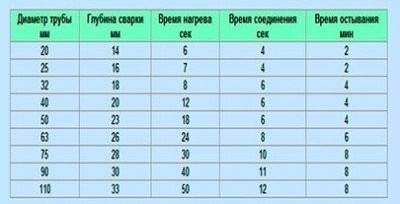
In the process of working with polypropylene pipes, the heating, joining and cooling of the elements should be observed. The quality and durability of the pipeline depend on this.
You can check the connection by looking inside. The formation of "sagging" is considered a marriage, as they affect the throughput of the highway. They can be the result of non-compliance with the melting temperature or if the pipe is inserted into the fitting further than necessary. In any case, such a defect affects the efficiency and service life of the pipeline.
Attention. Installation of polypropylene pipes should not be carried out in rooms whose air temperature is below 0 °.
If the polypropylene pipes are walled, then before you mount them into the wall, you must first collect the entire section of the highway.And only then mount it in the shtroba.
Connection of a polypropylene pipe with a metal
To connect pipes of various materials, such as metal and polypropylene, you need to use fittings that are equipped with threaded metal inserts. First, the fitting is welded to the polypropylene pipe, and then a metal pipe with an internal thread is screwed onto it. For better bonding, tow or flax is used.
More details here: Methods of connecting plastic pipes with metal: analysis of threaded and flange methods
Installation of polypropylene pipes to the surface
In the process of laying the pipeline there is a need to mount it to the surface. There are two ways to do this:
- conventional wall mount;
- sealing of pipes in the gate.
Both versions use special clips. They are selected according to the size of the pipes. Clips are attached to the surface with dowels and screws.
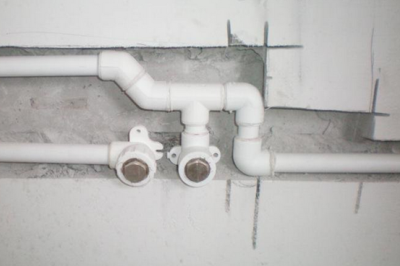
The section of the highway, which will be walled up in the gate, is first assembled, all its components are welded and only then mounted to the wall
There are two options for attaching pipes to the wall: rigid and sliding. Installation of water pipes from polypropylene pipes can be done using a rigid mount. But for heating mains, in places of expansion compensation, a sliding fastening should be done.
Other mounting nuances
Using polypropylene pipes in heating mains, you need to know how to mount them to the surface, taking into account thermal expansion. If the work is carried out at a temperature of 20 °, and the maximum value of the transported liquid is 110 °, then each meter of unreinforced pipeline is extended by 12 mm. Therefore, for heating mains, it is necessary to use only reinforced products. Their expansion is 2.4 mm. However, when laying the highway, it must be taken into account.
If the pipeline is walled up, you can use special covers. Due to their soft structure, they reduce the stress on the pipes. In addition, the casing reduces heat loss line. To compensate for expansion on the outer pipe, temperature compensators are arranged. They can be made in the form of loops, U-shaped or Z-shaped. Since polypropylene pipes are not plastic, bends are performed using fittings.
Having studied the theory of working with polypropylene pipes, you can proceed to the practical implementation of the process. The main thing is to strictly observe the technology. If you are not completely confident in your abilities, it is better to invite a specialist. After all, mistakes can be expensive. The quality of the measures taken can be judged after checking the highway under pressure.

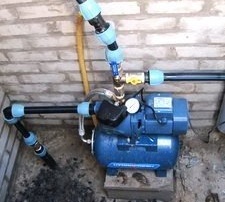
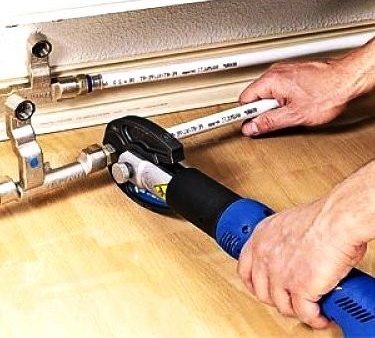
1 comment